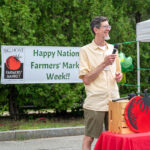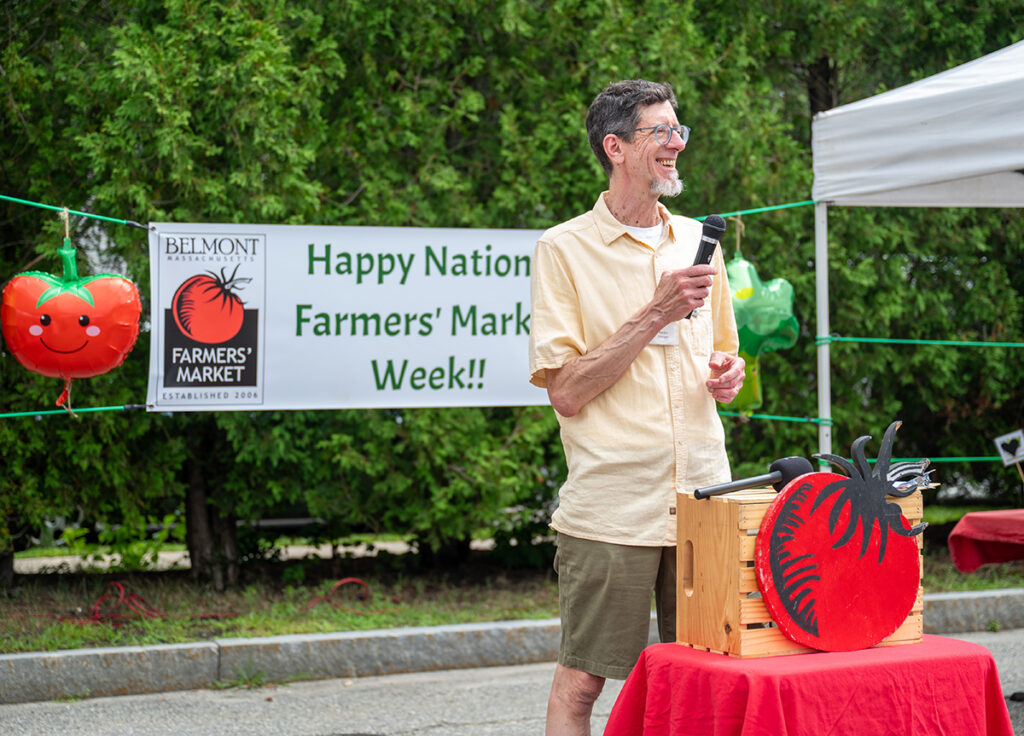
By Elissa Ely
Height comes with advantages (which many of us low to the ground wish we had). In Hal Shubin’s case, it’s one way to recognize him at the Belmont Farmers’ Market, where he’s chairman of the overseeing committee. You might already have recognized him, though, from his work with the Belmont Food Collaborative, or his three terms on the Board of Library Trustees, or his early involvement on The Belmont Voice, back when the weekly newspaper was still a list of suggested names. As he wrote on his LinkedIn page, “no rest for the retired.”
Hal’s farm awareness started early in life. Growing up on Long Island, “everything was a farming community.” One farm was reconfigured into a bowling alley, a shopping center, and the Shubin family home, with a farmstand behind the house. The neighborhood was close-knit, and reunions still draw former residents from around the country.
As a boy, Hal loved sports and AM Top-40 radio. His first real job was selling ice cream and soda in Shea Stadium; eventually, he was promoted to selling beer at the Nassau Coliseum. That was a mixed financial experience. Profits went down during concerts because he was too busy listening to the music.
He had no particular path in mind when he majored in chemistry at Albany University. But then, as he describes, “the most pivotal moment of my life: a friend said, ‘Take the Intro Computer Science class, it’s fun and easy. You’ll get a good grade.’ ” A master’s degree in computer science from Buffalo University followed, and after that, an entire life.
His move from upstate New York to Massachusetts in the 1980s was driven by temperature and common sense—“I wanted an upgrade in the weather from Buffalo,” he says. The move from Maynard to Belmont in 1994 was driven by schools and convenience; he and his wife had become parents by then, both working in Cambridge. Bicycling also let him pedal to talks that interested him at Harvard and MIT, and he still gets around that way. “I stop at bakeries,” he adds. Probably more of us should combine transportation with pastry.
Hal’s professional direction changed once he discovered user-experience design: eight enigmatic syllables that translate into creating easy, intuitive computer products. He conducted research with clients’ customers, studied program usability, designed workshops, developed prototypes. “The goal is to make software understandable to users and meet their needs,” he says—kind of a variant on creating chemistry labs that non-chemists can enjoy.
Over more than 25 years, he worked his way through a wide range of projects: dictation instruments for physicians, patent searches for lawyers, email marketing, speech-to-text translation. “When I was fixing forms for medical offices to file their Medicare claims, it wasn’t exciting,” he recalls, “but it made the work day easier for people and patients.”
User-experience design was invaluable in unforeseen areas, too. After COVID vaccines became available, the state established a labyrinthine website for booking appointments (and how many of us lost ourselves there, in one dim cave or another?). Hal volunteered with an Arlington software engineer who, frustrated like everyone, had the talent to create a workable alternative. He observed users of the state design, ran study sessions, fixed problems, and, when the website launched, became a customer. “I got my first shot that way.”
In 2006, the Belmont Farmers’ Market came into existence. It’s part of the Belmont Food Collaborative, a nonprofit umbrella organization including Belmont Composts, Belmont Helps, Belmont Food Pantry, and Community Gardening. Hal was involved in the market from its inception. “I like to eat, I like to cook, and it’s a half mile from my house,” he says straight-facedly. “But it’s more than that. It’s a community every week.”
It’s also an educational forum in the guise of a good time. The POP (Power of Produce) program hands kids $3 a week to buy fruit, produce, or plants. “I just can’t tell you how cool it is,” he says. “One kid said, ‘I tried garlic scapes. Not my favorite thing, but I still like ‘em.’” Financially strategic POP users save their money from week to week for higher purchase power at the end of the season. Extra dollars are awarded for joining the aerobic “Move It” hour, run last year by a local martial arts organization. And when the kids talk to farmers, it’s almost like getting their own hands in the soil.
Each week there is mingling on every level in the large parking lot behind Belmont Center. Market vendors become friends; some trade leftovers at the end of the day. Hal occasionally visits their farms. “It’s wonderful to see where your food’s grown,” he says. “I like blueberries, but not from Peru.” Market managers from different communities become friends, too—a Facebook page that shares their problems and solutions was especially essential in 2020, when there were two months to figure out how to run markets during COVID.
Alongside vendor stalls, artisan tents, education, music, motion, and wanderers with reusable bags, there are office hours. Select Board members, Representative Dave Rogers and Senator Will Brownsberger sometimes appear in person for dialogue (also, hopefully, for purchase).
Then, there are the services. This will be the fourth year for a Food Assistance Information Fair, where state organizations advise on Supplemental Nutrition Assistance Program (SNAP) and Women, Infants, and Children (WIC) applications. Hunger is no stranger to Belmont; almost 700 households receive SNAP for now, though Congress is contemplating a projected $230 billion withdrawal of federal sponsorship. Their benefits are doubled at the Farmers’ Market, and coupons also go to eligible seniors and WIC patrons. Supporting this funding, as well as POP, takes grant proposals and wooing sponsors; there is more to do.
All this programming throws a lot of spinning plates into the air. Even a tall person could have trouble juggling them at times. “Someone once said to me, ‘Why do you need a committee to run a Farmers’ Market?’”, Hal recalls. “I said, ‘It’s like running a bar mitzvah every week.’ We bring in 1,000 shoppers on average. Now if only we could control the weather.”
Running a perpetual bar mitzvah has had some consequences for the committee chairman. Hal doesn’t eat as much meat, and what he eats now has been humanely and healthily raised. Also, he keeps a garden, though it’s mostly shrubs and perennials. “I grow some tomatoes, cucumbers, herbs. “But,” he adds, “it turns out I know where to get really fresh local produce.”
Elissa Ely is a community psychiatrist.



Sorry, the comment form is closed at this time.